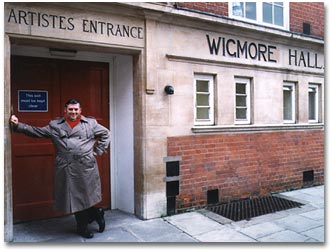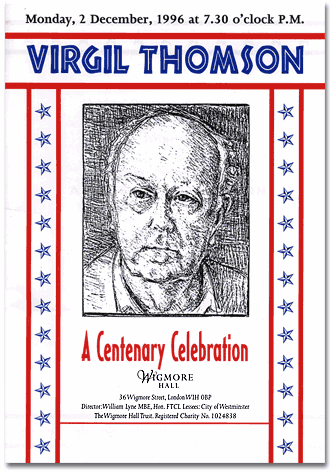
 |
|
previous page :: joyce | works | songs | concert | store | resources | contact | home :: map |
 |
Wigmore Hall"The Jewel in London's Musical Crown" 
Such is the well-deserved appellation bequeathed upon this famed venue by the Sunday Times, London's newspaper of record. Opened in 1901 as Bechstein Hall by the German piano firm of the same name, it is a beautiful structure, constructed of alabaster and marble in Renaissance style. The building was auctioned in 1916, due to the firm's financial difficulties precipitated by the Great War, but then reopened in 1917 as Wigmore Hall. The roster of artists who have performed here is a distinguished one and includes such names as Britten, du Pré, Prokofiev, Rubenstein, Saint-Saëns, and Segovia, to name but a very few. It remains a cherished venue for major international artists; and, with its celebrated acoustics, it has always been important to musicians giving their London débuts. Mr. McDermott's appearance here on December 2, 1996, marked a high point in his singing career. The occasion was a "Centenary Celebration" of works by the American composer Virgil Thomson, with pianists Rodney Lister and David Kopp also performing. (Mr. Lister, who had studied composition with Virgil Thomson, organized the concert.) One of the vocal highlights of the evening was a performance of the finale of Act One of Thomson's opera Lord Byron, the largest of his works and the culmination of his career as a composer. The libretto is by Jack Larson, who skillfully interweaves his own words with selections from Byron's poetry. In this scene, the text of the aria, which is drawn entirely from Cantos 10 and 11 of Byron's Don Juan, is sung by a statue of the poet that has been transported from Italy and uncrated in Westminster Abbey.
A mighty mass of brick and smoke and shipping, Among the other vocal works on this programme were two settings of texts by the American experimentalist Gertrude Stein. Thomson met Stein in Paris in 1926, and they "got on like two Harvard men." He soon began setting the writer's work to music, much to her delight. Thomson set the cheerful and completely obscure text of Preciosilla (his second Stein setting) as a grand Baroque recitative and air. Deux sœurs qui ne sont pas sœurs, written as a scenario for a film that was never made, tells the story of the acquisition by the Misses Stein and Toklas of their poodle, Basket I. Although an artistic collaboration between Virgil Thomson and James Joyce was well within the realm of possibility and almost certainly would have yielded interesting results, it was not to be. While in Paris, Thomson scrambled to find creative partners to help him achieve recognition and success. Through George Antheil he did meet Joyce, who invited the composer to develop a ballet based on Finnegans Wake. Gertrude Stein, however, always felt competitively jealous of Joyce and resented the public attention lavished on him; and Thomson knew that if he associated with Joyce, then Stein would sever their relationship. So he declined the invitation, alas, and the world is all the poorer for it. For more on the artistic collaborative process in general, and Thomson's work with Stein in particular, see Karren LaLonde Alenier's essay, Gertrude Stein Invents a Jump Early On. |